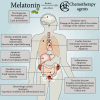Utilizing Melatonin to Alleviate Side Effects of Chemotherapy: A Potentially Good Partner for Treating Cancer with Ageing
- PMID: 32566095
- PMCID: PMC7260648
- DOI: 10.1155/2020/6841581
Utilizing Melatonin to Alleviate Side Effects of Chemotherapy: A Potentially Good Partner for Treating Cancer with Ageing
Abstract
Persistent senescence seems to exert detrimental effects fostering ageing and age-related disorders, such as cancer. Chemotherapy is one of the most valuable treatments for cancer, but its clinical application is limited due to adverse side effects. Melatonin is a potent antioxidant and antiageing molecule, is nontoxic, and enhances the efficacy and reduces the side effects of chemotherapy. In this review, we first summarize the mitochondrial protective role of melatonin in the context of chemotherapeutic drug-induced toxicity. Thereafter, we tabulate the protective actions of melatonin against ageing and the harmful roles induced by chemotherapy and chemotherapeutic agents, including anthracyclines, alkylating agents, platinum, antimetabolites, mitotic inhibitors, and molecular-targeted agents. Finally, we discuss several novel directions for future research in this area. The information compiled in this review will provide a comprehensive reference for the protective activities of melatonin in the context of chemotherapy drug-induced toxicity and will contribute to the design of future studies and increase the potential of melatonin as a therapeutic agent.
Copyright © 2020 Zhiqiang Ma et al.
Conflict of interest statement
The authors declare no competing interests regarding the publication of this manuscript.
Figures


References
Publication types
MeSH terms
Substances
LinkOut - more resources
Full Text Sources
Medical

